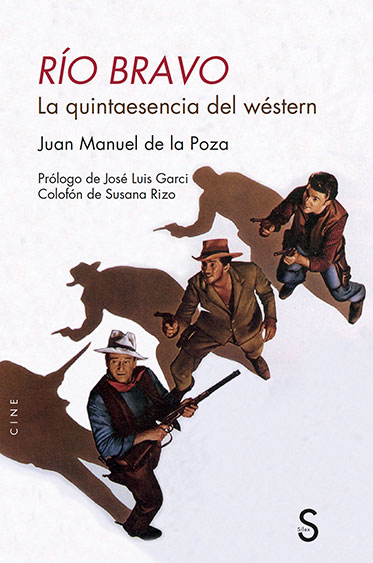“In ‘Río Bravo’, I insist, there is all of Hawks’ cinema and almost all of the Hollywood cinema of the golden years” says the great José Luis Garci in the prologue of this book, and if one genre has defined American cinema it is the western, and if any film encapsulates everything that the western is, it is “Bravo River”.
In this essay of more than four hundred pages, Juan Manuel de la Poza dissects the relevance of Howard Hawks’ film and its importance in the history of cinema. The author manages to analyze all aspects of the film and put them in context. Why is the presence of John Wayne essential? What cultural impact does the interpretation of “My rifle, My Pony And Me” directed by Ricky Nelson and Dean Martin? What political statement does this film represent regarding the release of “Only in the face of danger” (Fred Zinnemann, 52)?… The book allows the lover of Westerns, and of cinema in general, to see beyond the film itself to delve into its production, its cast and its historical context.
The devotion that de la Poza feels for “Bravo River” and for the cinema of Howard Hawks. Despite the analytical and academic nature of his paragraphs, the author cannot avoid always positioning himself in favor of the protagonists (Hawks, Wayne, old Hollywood…) and being reluctant to the detractors they may have. That’s one of the biggest problems with the book. What seems like an academic study at times becomes a tooth and nail defense of a work released sixty-five years ago. He seems to want to fight a war that no one else is fighting, as if critics who didn’t understand the film in the 1950s still haunt him today. As if in the 21st century there was a debate regarding whether “Bravo River” It is one of the best films of its genre.
Another obstacle in reading this essay is that its academic nature requires a structure that conditions the reading pace. Therefore, we find lists of works and dates that can occupy entire pages and divert attention from the central thesis. Despite the interest that the analysis may arouse and the depth with which it is done, four hundred pages are somewhat excessive to talk about, after all, a single film and the author enters into redundancies when talking about the same aspect from different prisms. , with paragraphs practically traced to those of previous chapters.
The strong point of the book is undoubtedly the depth of analysis and the patience and space that de la Poza dedicates to each section. She dedicates several chapters to talking about other films such as “The Alamo” (John Wayne, 60), “Red River” (Howard Hawks, 48) o “The Golden” (Howard Hawks, 66) and at no time does the reader have the feeling of moving away from the central idea of the text. Everything works to build the global, multifaceted and complete idea that is (for the author and for the history of cinema) “Río Bravo”.
“Río Bravo: The quintessence of the western” It is, in short, a detailed study of a film that is much more than that, and focuses on the cultural, historical and cinematographic impact it had on North American society in the late 1950s. With this book, we not only know the film better, but we delve into the biographies of Howard Hawks, John Wayne or Dean Martin, and we understand why so many masters of film history highlight “Río Bravo” as one of the greatest films Americans of all time.
